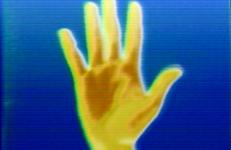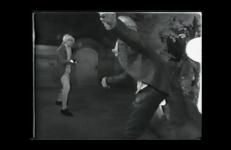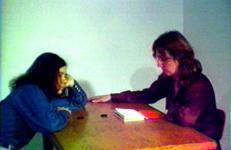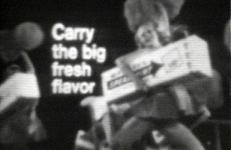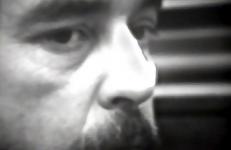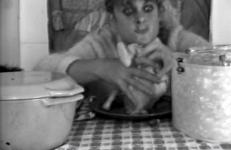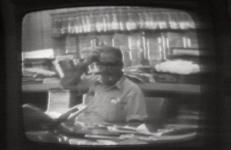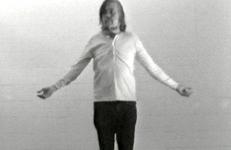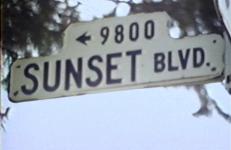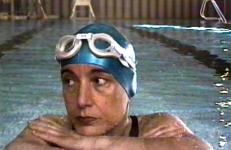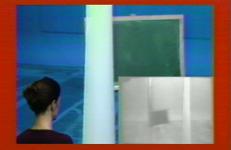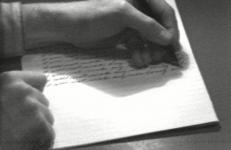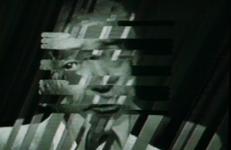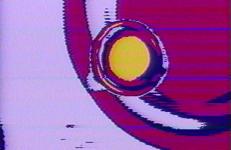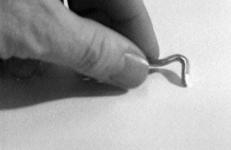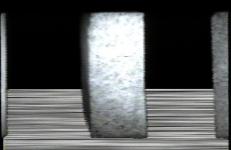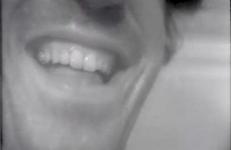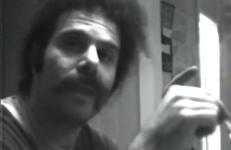TVTV's inside view of the 1972 Republican National Convention made broadcast history. While network cameras focused on the orchestrated renomination of Richard Nixon, TVTV's rag-tag army of guerrilla television activists turned their cameras on to the cocktail parties, anti-war demonstrations, hype and hoopla that accompanied the show.
Video History
"Actions, states, one B+W video camera, the Paik Abe Colorizer, a video switcher. The two states, a b a b, I put my hand in the camera frame and saw a colored hand shifting. I moved my, the, hand, including back and forth, realizing or connecting to the visual and language potential of front hand and back hand. Giving it some veracity, the pace became about attempting to keep up with the position changes together with verbally reciting front hand back hand, co-coordinating from hand to mouth and mouth to hand."
– Peer Bode
In the wake of Lord of the Universe, TVTV planned to cover the impeachment of Richard Nixon, but, unfortunately, Nixon resigned. The group made a ninety-degree turn to covering the “first hundred days” of the Gerald Ford administration, a cavalcade of photo ops and campaign appearances. In Part One of the four-part series, entitled WIN (referring to the Ford slogan, “Whip Inflation Now”), TVTV goes on a whirlwind across-country trek with Ford, stopping in Sioux City, Iowa, Salt Lake City, and Portland. The show is more about Ford’s public than Ford.
Arguably, the most successful of the four “Gerald Ford’s America” shows was “Chic To Sheik,” a TVTV tour of the private culture of the official Washington. Lead by Megan Williams, they blithely move around an official White House tea for Betty Ford at the beginning and cavort at the Shah of Iran’s birthday party at the Iranian Embassy at the end. Shot with almost open access because this was when even public people, in private, were innocents before a documentary camera. Washington Post Society Editor, Betty Beale, leads the way. A gem.
A table is set with two red books placed at diagonal corners and a stack of three poker chips placed in the center. Two women enter, sit, and begin to play with the books and poker chips. Different soundtracks converge; the dialogue begins to sound like an interrogation as one character asks, “What is the structural definition of logical positivism? Lawrence Weiner, what is the structural form as in the manner and use of your language? Does it not have a direct relation to logical positivism?”
In Greetings from Lanesville, the Videofreex tour the countryside of Lanesville, New York interviewing the local people for a weekly broadcast program all from behind the wheel of the Lanesville TV Media Bus. As the first localized pirate television station, Lanesville TV brought its guerilla broadcasting to Upstate New York with interviews of ordinary townspeople in an effort to present an image of community created by the community itself.
Using imagery from a Japanese "creature feature" and a chewing gum commercial, Benglis's camera focuses on different parts of the screen to emphasize different messages. With dialogue and sound replaced by the sound of frogs croaking outside Benglis's studio, the absurdly comic visuals of the movie and commercial oddly begin to echo each other, raising questions about the nature of the absurdity beamed into our homes and uncritically accepted as entertainment.
This title was in the original Castelli-Sonnabend video art collection.
Robert Heineken (1931-2006) used technically sophisticated photographic methods to mingle erotic images with visuals from TV and advertising. The American artist was known for appropriating and re-processing images from magazines, product packaging or television. In the "Are You Real" series from 1964 to 1968, he created a portfolio of images filled with unexpected and sometimes surreal juxtapositions by placing a single magazine page on a light table, so that the resulting contact print picks up imagery from both sides of the page.
In this cooking demonstration/performance, Sobell wears a chicken carcass over her face while dressing (literally, in baby clothes) a chicken to be cooked for dinner. Cooing and breast feeding the chicken as she would an infant, Sobell brings two stereotypical female roles—that of care giver and that of cook—psychotically close, emphasizing the potential dark side of women’s intimate association with food in a way similar to Suzanne Lacy’s Learn Where the Meat Comes From.
In Home Tape Revised, Benglis took a portable tape recorder with her when she visited her family in Louisiana. She saw most of the experience through the video camera, thus giving her a distance from an emotionally involving situation. The tapes were replayed and re-shot off a monitor and commented about by Benglis... It is a deeply personal tape about an emotionally involving situation, but it is precisely controlled.
There is a crudeness to How's Tricks, Benglis's first venture into narrative fiction. No attempt is made to hide the mechanics of making the tape. At one point, while Benglis and [Stanton] Kaye argue about the tape they are making of [Bobby] Reynolds (a real-life carny who also appears in The Amazing Bow-Wow), Kaye is seen reaching over to turn off the video recorder — and thus the scene ends...
There is a crudeness to How's Tricks, Benglis's first venture into narrative fiction. No attempt is made to hide the mechanics of making the tape. At one point, while Benglis and [Stanton] Kaye argue about the tape they are making of [Bobby] Reynolds (a real-life carny who also appears in The Amazing Bow-Wow), Kaye is seen reaching over to turn off the video recorder — and thus the scene ends...
“A good example of Baldessari’s deadpan irreverence is the 1971 black-and-white video entitled I Am Making Art, in which he moves different parts of his body slightly while saying, after each move, ‘I am making art.’ The statement, he says, ‘hovers between assertion and belief.’ On one level, the piece spoofs the work of artists who, in the late 1960s and early 1970s, explored the use of their own bodies and gestures as an art medium.
Segalove comes out as the child of a movie star haven where messy lawns are reported to the police and designer labels are removed from hand-me-downs for the maids. She reveals some of the dirt among the manicured yards, including a local custom of girls jumping from a terraced lawn at Beverly Hills High to induce miscarriages, and her friend Yasmin Hayworth’s wish that Rita was a “natural mother.”
I Stare at You and Dream is a slice of life melodrama that journeys to the core of interrelationships. This film juxtaposes and links the lives of four people: the filmmaker, Susan Mogul; her friend, Rosie Sanchez; Rosie’s teenage daughter, Alejandra (Alex) Sanchez; and Ray Aguilar; Susan’s-on-and-off boyfriend. Tender and unflinching, each character gradually reveals their desires, wounds, and romantic entanglements in the context of their everyday lives.
Jonas intercuts scenes of the Nova Scotia countryside with images of a studio set-up reminiscent of a di Chirico painting. The soundtrack includes both music and spoken excerpts from a journal Jonas kept while travelling in Nova Scotia. I Want to Live in the Country ultimately deals with observation and fantasy, living in the country, and the stifling aspects of the city and one's art.
This title was in the original Castelli-Sonnabend video art collection.
“‘I will not make any more boring art,’ John Baldessari wrote over and over again in a work done in 1971. The impulse for the piece, he says, came from dissatisfaction with the ‘fallout of minimalism,’ but its implications are far greater. It is typical of Baldessari’s work, for not only is it extremely funny, but it is also a strategy, a set of conditions, a directive, a paradoxical statement, and a commentary on the art world with which it is involved. Like all his work to date, it addresses, on many complex levels, issues about art, language, games and the world at large.”
Using the image processor as it was intended as a performance instrument, Icron exploits the processor’s real-time capabilities: the image and soundtrack were generated through simultaneous improvisation, although the color was added later. The title of the piece is a neologism created by fusing "icon" with "chron" as a reference to the effect of temporal changes on images. Snyder combines iconographic elements of broadcast television with the structural features of music by deconstructing the face of a newscaster into scan lines.
Skip Sweeney was an early and proficient experimenter with video feedback. A feedback loop is produced by pointing a camera at the monitor to which it is cabled. Infinite patterns and variations of feedback can be derived from manipulating the relative positions of camera and monitor, adjusting the monitor control, becoming a swirling vortex. Sweeney and others were intrigued with feedback's ability to generate pulsing images like a living organism.
“In Baldessari’s wonderful Inventory, the artist presents to the camera for thirty minutes an accumulation of indiscriminate and not easily legible objects arranged in order of increasing size and accompanied by a deadpan description — only to have the sense of their relative size destroyed by the continual readjustment of the camera [in order to] keep them within the frame. Who can forget Adlai Stevenson’s solemn television demonstration of the ‘conclusive photographic evidence’ of the Cuban missile sites, discernible over the TV screen as only gray blurs?”
"Bricks, white noise, video. Free floating sync, altered, drifiting camera: video image and time. Keying permutations, switching via gray level values, using a modified b+w Sony special effects generator (SEG). Building the building, one brick at a time. In video what is a brick? In spite of what was then a fierce cultural doxa, an anti-materialist pressure, and being quite anti-anti-materialist I was working hard to coax out significant features as expressive intensity zones, electronic energy points always engaging with the signals."
– Peer Bode
Using selected details of TV’s Hollywood Squares, Birnbaum constructs an analysis of the coded gestures and “looks” of the actors, including Eileen Brennen and Melissa Gilbert. Birnbaum exposes television as an agent of cultural mimicry and instruction. The actors’ expressions are far from valueless; they are the ideological content of such programming.
In Laser Games with Shirley Clarke, the Videofreex visit the apartment of independent filmmaker Shirley Clarke. Someone brings out a laser pointer, which they then use from the top of their building to shine on the sidewalks below in an attempt to distract the passersby. After returning indoors, they experiment with optical distortion by shooting the laser directly into the camera lens while listening to psychedelic raga music.
In this video, the Videofreex host a party during which the main source of entertainment is a video-television feedback loop. In one room, a video camera linked up to a television set allows party guests to see themselves, as if in a mirror, while guests in the other room can also watch the recording, and may speak to them through a microphone. Although the voices of the off-screen guests can be heard on the tape, they are always imageless.
Timely concerns about the future of video, artists’ complicity in the money making system of the ‘establishment,’ and the effect of the camera’s presence on personal encounters, is discussed and debated in this late night video produced by David Cort, Chuck Kennedy, and Skip Blumberg.





